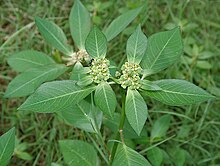Rosids
| Rosids Temporal range: Cretaceous - Presente
| |
|---|---|

| |
| Euphorbia heterophylla | |
| Sayantipiko na klasipikasyon | |
| Kahadean: | Plantae |
| Klado: | Angiosperms |
| Klado: | Eudicots |
| Klado: | Core eudicots |
| Klado: | Superrosids |
| Klado: | Rosids |
| Orders[1] | |
An mga rosids miyembro kan dakulang clade (monophyletic na grupo) kan mga tinanom na nagbuburak, igwa nin maabot sa 70,000 espesye, halos sangkapat kan gabos na Angiosperms.[2]
An clade nababanga sa 16 hanggang 20 order, depende sa circumskripsiyon asin klasipikasyon. Ining mga order na ini, nagbubuo nin halos 140 pamilya.[3]
An mga fosil kan rosids nabisto pa na nagpuon sa pahaon kan Cretaceous. An Molecular clock nag-eestima na an mga rosids gikan sa Aptian o Albian na estado kan Cretaceous, sa pagitan kan 125 asin 99.6 milyon taon na an nakaagi.[4][5]
An ngaran
[baguhon | baguhon an source]An ngaran gikan sa "Rosidae", na mabibisto bilang sarong subklase. Kan 1967, si Armen Takhtajan nagpahiling nin tamang basehan para sa ngaran na "Rosidae", sarong deskripsiyon kan grupo kan mga tanom na naipublikar kan 1830 ni Friedrich Gottlieb Bartling.[6] Dai naghaloy an clade pinangaran nin "Rosidae".
Igwang tulong(3) pakahulugan para sa mga rosids na ginamit. An ibang mga parasurat isinali an mga order na Saxifragales asin Vitales sa mga rosids.[7] An iba hinali an parehong order.[8]Sa artikulong ini an ginamit na pakahulugan base sa APG IV na klasipikasyon, na nagsasali kan Vitales, pero hinali an Saxifragales.
Mga relasyon
[baguhon | baguhon an source]An mga rosids asin Saxifragales porma kan superrosids na clade.[9][8] Saro ini sa tolong grupo na nagbubuo kan Pentapetalae (core eudicots minus Gunnerales),[10] asin an iba Dilleniales asin superasterids (Berberidopsidales, Caryophyllales, Santalales, and asterids).[8]
Klasipikasyon
[baguhon | baguhon an source]An rosids binubo kan duwang grupo: an order kan Vitales asin kan eurosids (totoong rosids). An eurosids, binanga sa duwang grupo: fabids (Fabidae, eurosids I) asin malvids (Malvidae, eurosids II).[8]
Mga order
[baguhon | baguhon an source]An rosids binubuo kan 17 order. Bilang dugang sa Vitales, igwa nin 8 order sa fabids asin 8 order sa malvids. An iba dai pa sana nahahaloy na naipabisto.[8] Ini iyo an Vitales,[11] Zygophyllales,[12] Crossosomatales,[13] Picramniales,[14] asin Huerteales.[15]
Phylogenyo
[baguhon | baguhon an source]An phylogeny kan rosids na ipinapahiling sa ibaba, ginuno sa Angiosperm Phylogeny Group website.[8]
| eurosids |
| ||||||||||||||||||||||||||||||||||||||||||||||||||||||||||||||||||||||||||||||||||||||||||
Toltolan
[baguhon | baguhon an source]- ↑ Angiosperm Phylogeny Group (2016). "An update of the Angiosperm Phylogeny Group classification for the orders and families of flowering plants: APG IV". Botanical Journal of the Linnean Society 181 (1): 1–20. doi:.
- ↑ Scotland, Robert W.; Wortley, Alexandra H. (2003), "How many species of seed plants are there?", Taxon, 52 (1): 101–4, doi:10.2307/3647306, JSTOR 3647306
- ↑ Soltis, Douglas E.; Soltis, Pamela S.; Peter K. Endress; Mark W. Chase (2005), Phylogeny and Evolution of the Angiosperms, Sunderland, MA, USA: Sinauer, ISBN 978-0-87893-817-9
- ↑ Davies, T.J.; Barraclough, T.G.; Chase, M.W.; Soltis, P.S.; Soltis, D.E.; Savolainen, V. (2004), "Darwin's abominable mystery: Insights from a supertree of the angiosperms", Proceedings of the National Academy of Sciences, 101 (7): 1904–9, Bibcode:2004PNAS..101.1904D, doi:10.1073/pnas.0308127100, PMC 357025
 , PMID 14766971
, PMID 14766971
- ↑ Magallón, Susana; Castillo, Amanda (2009), "Angiosperm diversification through time", American Journal of Botany, 96 (1): 349–365, doi:10.3732/ajb.0800060, PMID 21628193
- ↑ Reveal, James L. (2008), "A Checklist of Family and Suprafamilial Names for Extant Vascular Plants", Home page of James L. Reveal and C. Rose Broome
- ↑ Burleigh, J. Gordon; Hilu, Khidir W.; Soltis, Douglas E. (2009), File 7, "Inferring phylogenies with incomplete data sets: a 5-gene, 567-taxon analysis of angiosperms" (PDF), BMC Evolutionary Biology, 9: 61, doi:10.1186/1471-2148-9-61, PMC 2674047
 , PMID 19292928, archived from the original (PDF) on 2012-01-18, retrieved 2019-09-09
, PMID 19292928, archived from the original (PDF) on 2012-01-18, retrieved 2019-09-09
- ↑ 8.0 8.1 8.2 8.3 8.4 8.5 Stevens, Peter F. (2001), Angiosperm Phylogeny Website
- ↑ Wang, Hengchang; Moore, Michael J.; Soltis, Pamela S.; Bell, Charles D.; Brockington, Samuel F.; Alexandre, Roolse; Davis, Charles C.; Latvis, Maribeth; Manchester, Steven R.; Soltis, Douglas E. (10 March 2009), "Rosid radiation and the rapid rise of angiosperm-dominated forests", Proceedings of the National Academy of Sciences, 106 (10): 3853–8, Bibcode:2009PNAS..106.3853W, doi:10.1073/pnas.0813376106, PMC 2644257
 , PMID 19223592
, PMID 19223592
- ↑ Cantino, Philip D.; Doyle, James A.; Graham, Sean W.; Judd, Walter S.; Olmstead, Richard G.; Soltis, Douglas E.; Soltis, Pamela S.; Donoghue, Michael J. (2007), "Towards a phylogenetic nomenclature of Tracheophyta" (PDF), Taxon, 56 (3): 822–846, doi:10.2307/25065865, JSTOR 25065865
- ↑ Reveal, James L. (1995), "Newly required suprageneric names in vascular plants", Phytologia, 79 (2): 68–76 See p. 72
- ↑ Chalk, L. (1983), "Wood structure", in Metcalfe, C.R.; Chalk, L., Wood Structure and Conclusion of the General Introduction, Anatomy of the Dicotyledons, II (2nd ed.), Clarendon Press, pp. 1-51 [1-2 by C. R. Melcalfe], ISBN 978-0-19-854559-0
- ↑ Kubitzki, Klaus, ed. (2007), "Introduction to Crossosomatales", Flowering Plants. Eudicots: Berberidopsidales, Buxales, Crossosomatales, Fabales p.p., Geraniales, Gunnerales, Myrtales p.p., Proteales, Saxifragales, Vitales, Zygophyllales, Clusiaceae Alliance, Passifloraceae Alliance, Dilleniaceae, Huaceae, Picramniaceae, Sabiaceae, The Families and Genera of Vascular Plants, IX, Springer, ISBN 978-3-540-32219-1
- ↑ Hutchinson, John (1979) [1973], The Families of Flowering Plants (3rd ed.), Oxford University Press, ISBN 9783874291606
- ↑ Worberg, Andreas; Alford, Mac H.; Quandt, Dietmar; Borsch, Thomas (2009), "Huerteales sister to Brassicales plus Malvales, and newly circumscribed to include Dipentodon, Gerrardina, Huertea, Perrottetia, and Tapiscia", Taxon, 58 (2): 468–478, doi:10.1002/tax.582012
